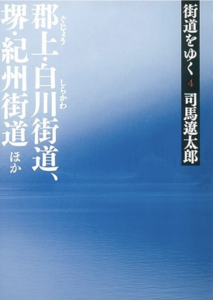Life Tips & Miscellaneous Travel and History Zen Philosophy and History Art and Sport Navigation of this blog
Summary
Travel is an act for human beings to visit new places and experience different cultures and histories. Through travel, people can actually feel historical events and people’s lives by visiting historical places and cultural heritage sites, and can gain a deeper understanding of history and broaden their own perspectives. In this section, we will discuss the historical background of the trip and the places visited based on Ryotaro Shiba’s “Kaido yuku” (On the Road) about this journey and history.

Kaidou wo yuku Vol.4 Gujo/Shirakawa Road and Ecchu Road .
In the previous article, we discussed the Sakai-Kishu Highway. This time, we will discuss the Gujo/Shirakawa Highway and the Etchu Highway.
Gujo/Shirakawa Road and Ecchu Road
This time, we will discuss the Echchu Road, which runs from the Pacific Ocean near the center of Japan to the Sea of Japan, through Gifu Prefecture to the famous World Heritage Site of Shirakawa-go, and on to Toyama Prefecture.

The trip starts at Gifu Hatori Station, the only Shinkansen station in Gifu Prefecture (located between Nagoya and Maibara stations, where only Kodama stops).

The Hokuriku region was a place where Jodo Shinshu, spread by Shinran, flourished, and this is the story of the Echu monks of Jodo Shinshu who led the Ikkyu Ikkoku revolt that flourished during the Warring States period. Shinran’s Jodo Shinshu, as previously mentioned, was a religion called “Yi-gyo-do,” which meant that there was no asceticism or hardship, and that one could be picked up by the Buddha’s true desire in the form of the floating world and live a life of rebirth. In the Kanto region, Zen, represented by Dogen, and esoteric Buddhism, represented by Kukai, were popular.
While driving northward from Gifu Hatori Station through Gifu City, the story shifts to “Kunitobori Monogatari,” a novel written by Saito Doso, who went from being an oil peddler to becoming the lord of Mino and Oda Nobunaga, who lost his life when his men rebelled against him and he was one step away from the unification of Japan.

When Doso Saito was in Mino, oil was supposed to be squeezed from EGoma (sesame), and it was not possible to get a large amount of oil, so the common people were not able to light fires at night.

In the same period, a game-changing event took place in which oil was squeezed from rape blossoms in large quantities, and apparently the price of oil dropped so much that even common people were able to use lights at night.

Kinkasan, where the castle of Dosan was located, becomes a mountain with the Nagara River, a first-class river that flows through Gifu Prefecture and heads from Nagoya to the Pacific Ocean, flowing at its foot.

Kinkasan, the group headed for Gujo Hachiman Castle on the upper reaches of the Nagara River.

It is famous as one of the “castles in the sky” floating in a sea of clouds, and is the oldest reconstructed wooden castle in Japan, whose owners changed from the Warring States Period to the Edo Period. In Gujo Hachiman, visitors buy candy balls with meat cakes, a local specialty.

This is also called Nikki candy, and appears to be a simple tasting candy made of brown sugar and Nikki.
Going north from the Gujo Kaido, the Hida Kaido or Shirakawa Kaido passes through the mountains. After following the Shirakawa Highway for a while, you will arrive at Lake Mihoro and the Mihoro Dam.

The area around Lake Gomogi is said to be a scenic place with beautiful autumn leaves and cherry blossoms. The area around Mihoro is a mountain village called Shirakawa Valley. Further north along the valley, you will reach Shirakawa-go, which is also famous as a World Heritage site.

Here, many old Japanese houses in the gassho-zukuri style are left as tourist attractions. In Shirakawa Valley, Ryotaro Shiba and his friends participate in a local festival called Doburoku Festival and drink doburoku.
Further north from Shirakawadani, the area approaches Toyama Prefecture and arrives at Gokayama. Here, as in Shirakawa-go, one can see Japanese-style houses built in the gassho-zukuri style. After passing Gokayama, we will pass by Gyotokuji Temple, an old temple in Toyama.

Entering Toyama, we see the Tateyama mountain range, known as the Japanese Alps. Toyama Prefecture has a low, elongated, sea-cucumber-shaped hill called Mt. Kureha rising in the center, and the Toyama Plain is divided by this mountain into Kurehigashi and Kurenishi, which in turn divide the prefecture into the Kanto cultural zone and Kansai cultural zone, with different dialects, lifestyles and business practices.

Tateyama is also a sacred mountain, and there is a village with ancient Shinto priests called onshi (oshi). Onshi were originally a group of ascetic practitioners who began as ascetic ascetics, and they were priests who ran lodges for pilgrims who visited shrines and prayed by themselves. For example, the Ise Jingu Shrine had its own “goishi” (priests), who were in charge of visitors who came from all over Japan. In the case of Tateyama, the mountain itself is a god, so an oshi is a mountain guide.
In the next article, I will discuss the Tamba-Sasayama Highway.


コメント